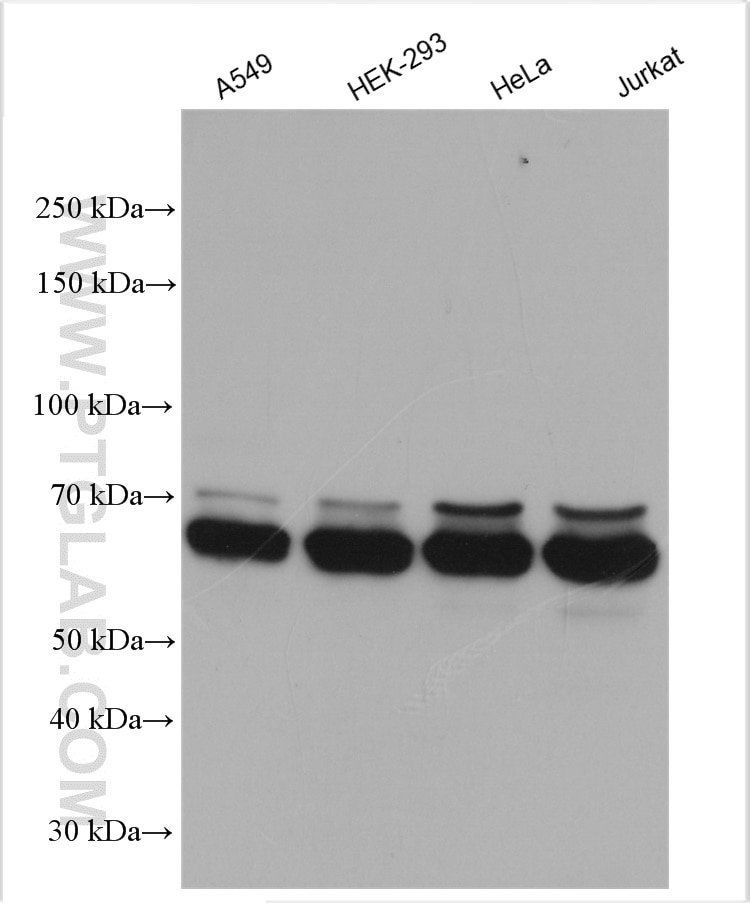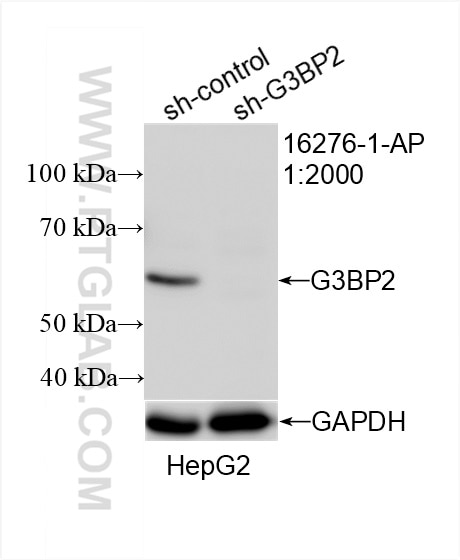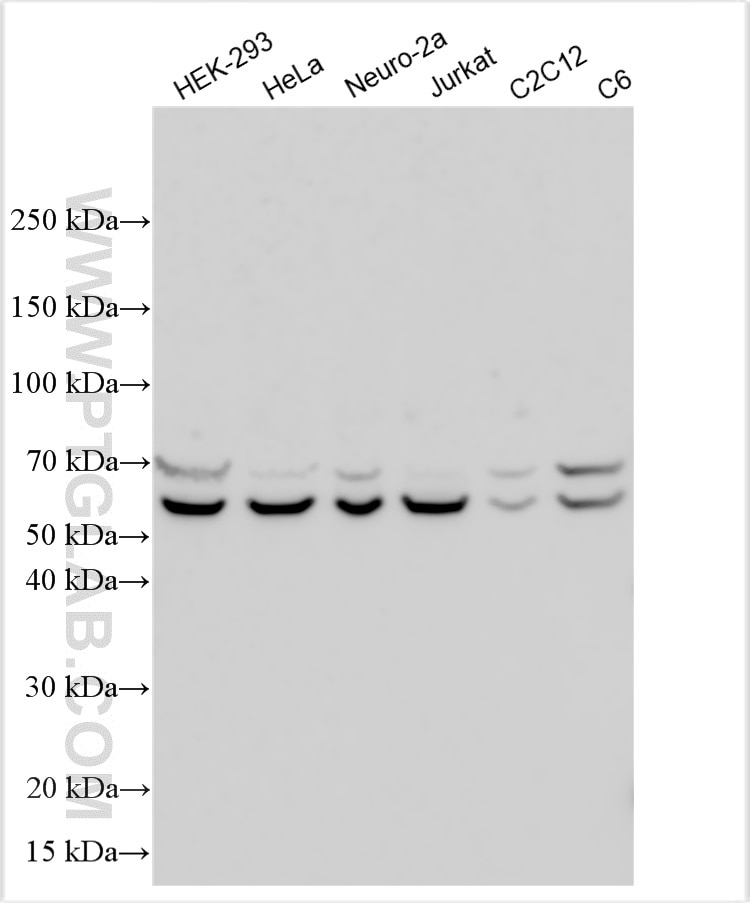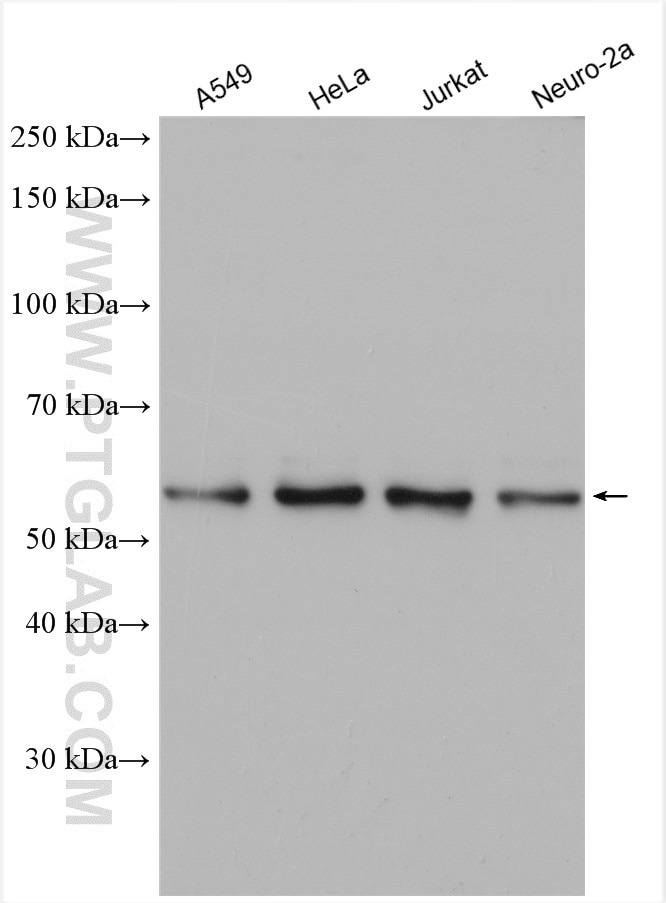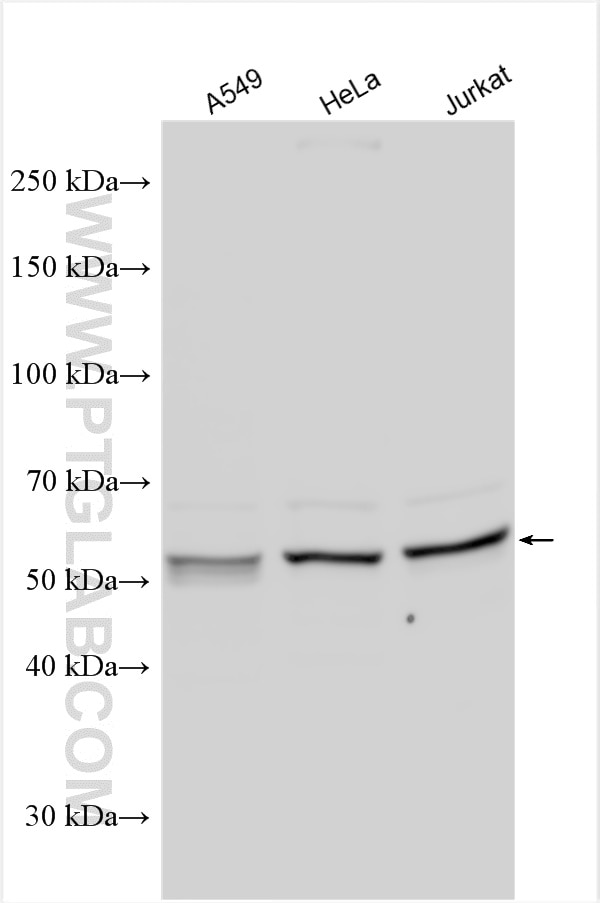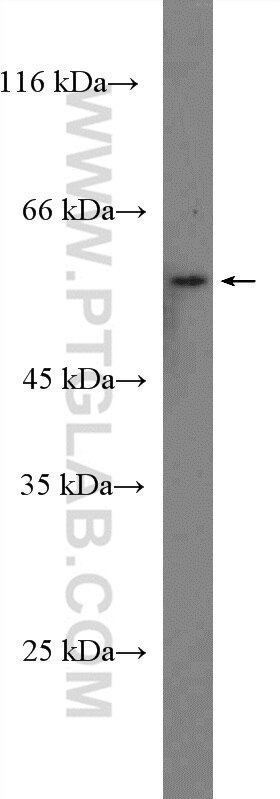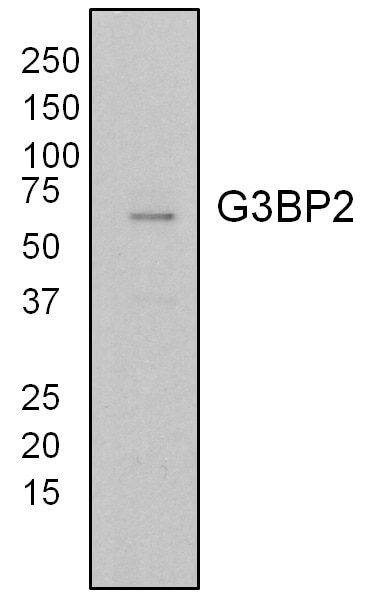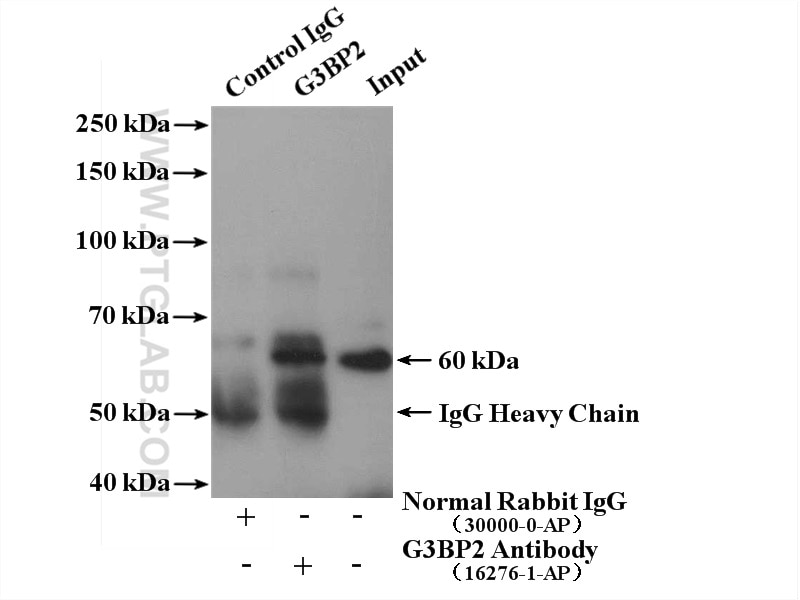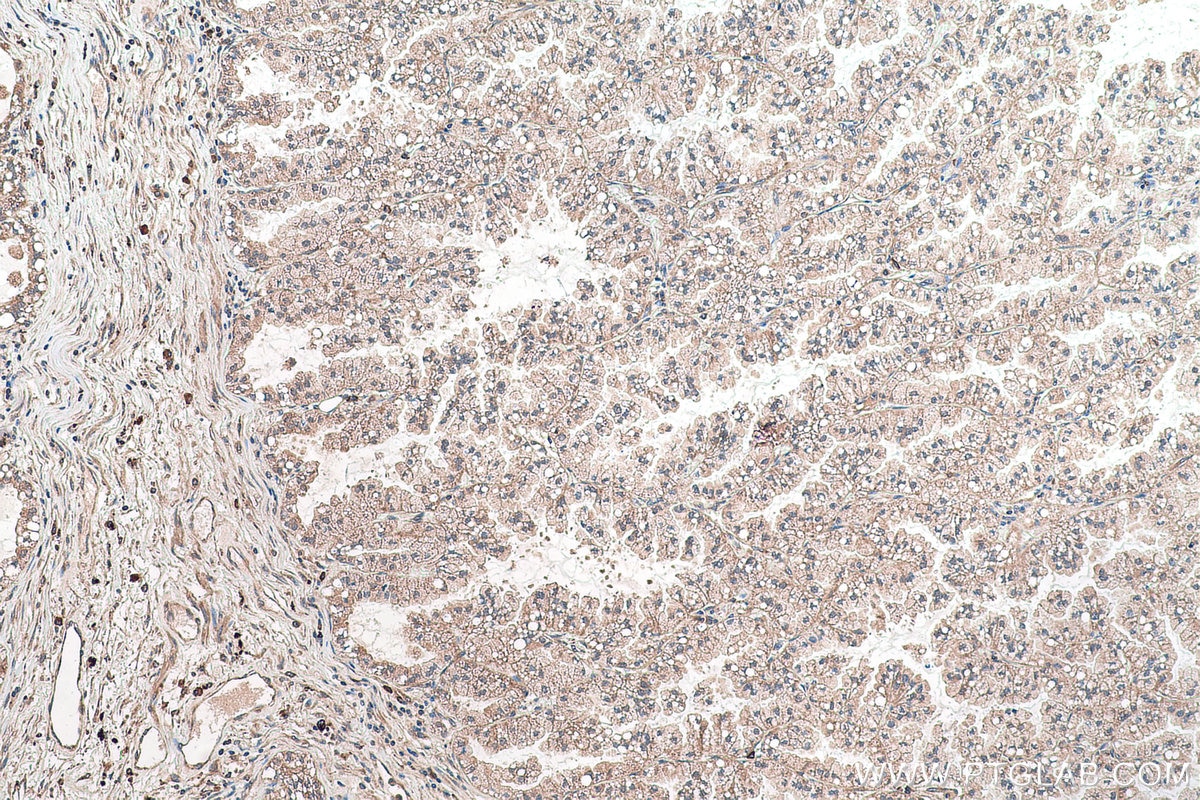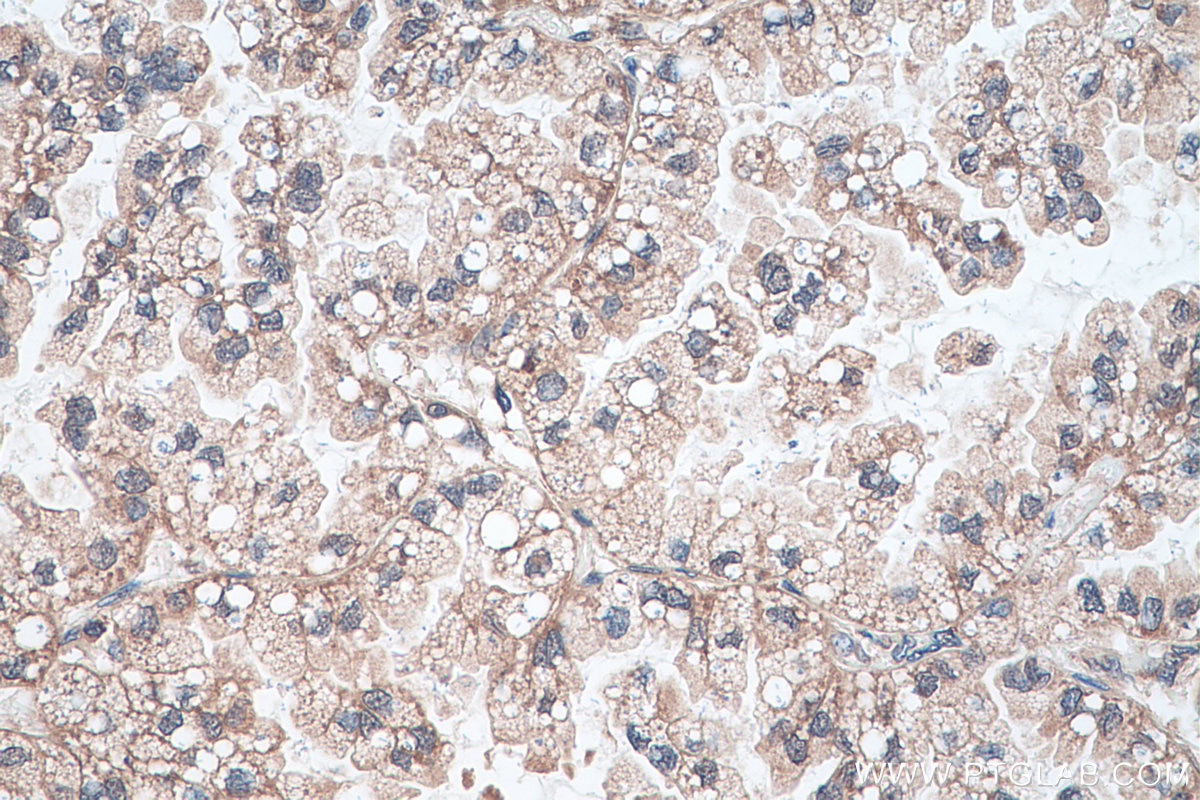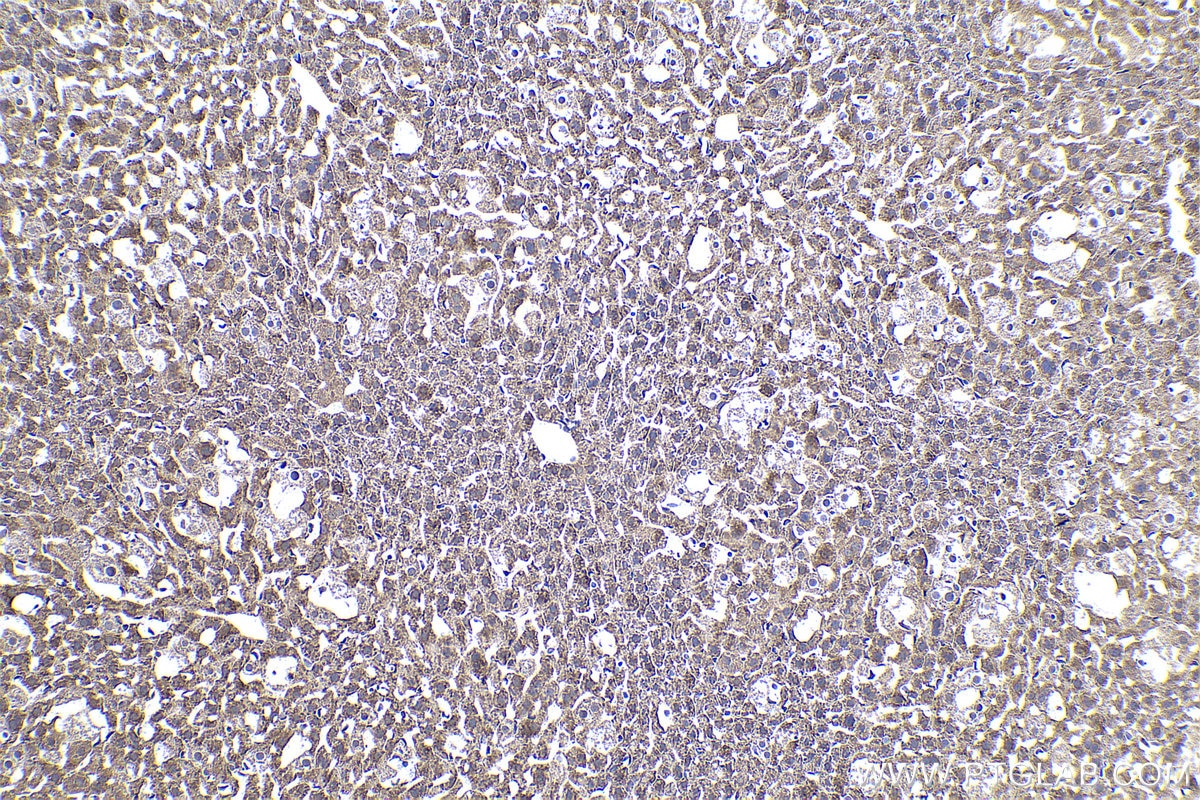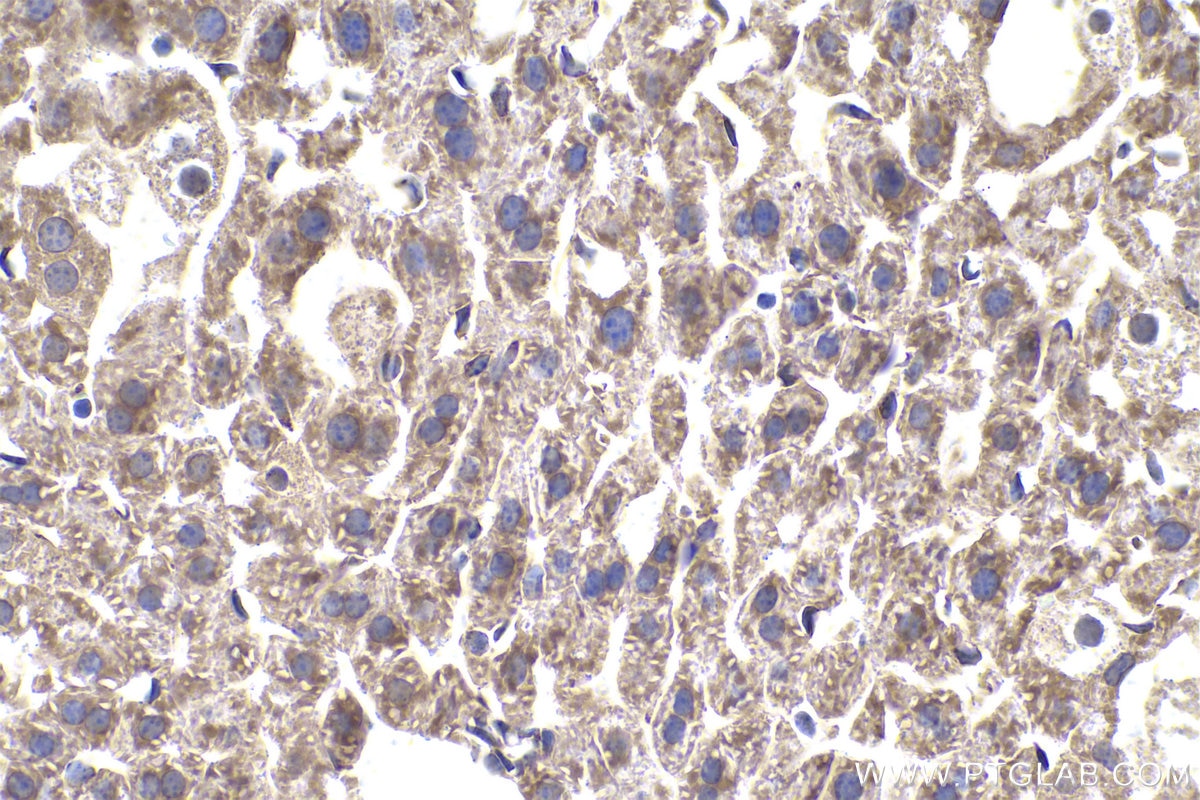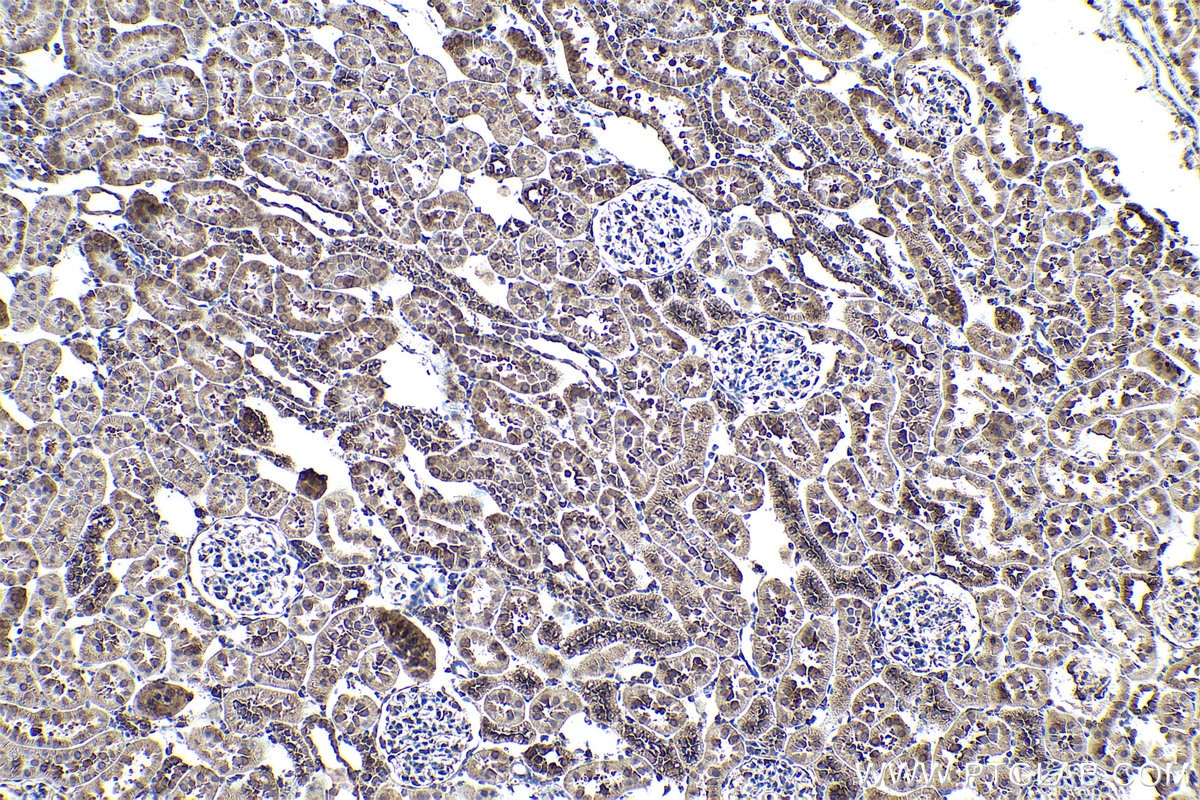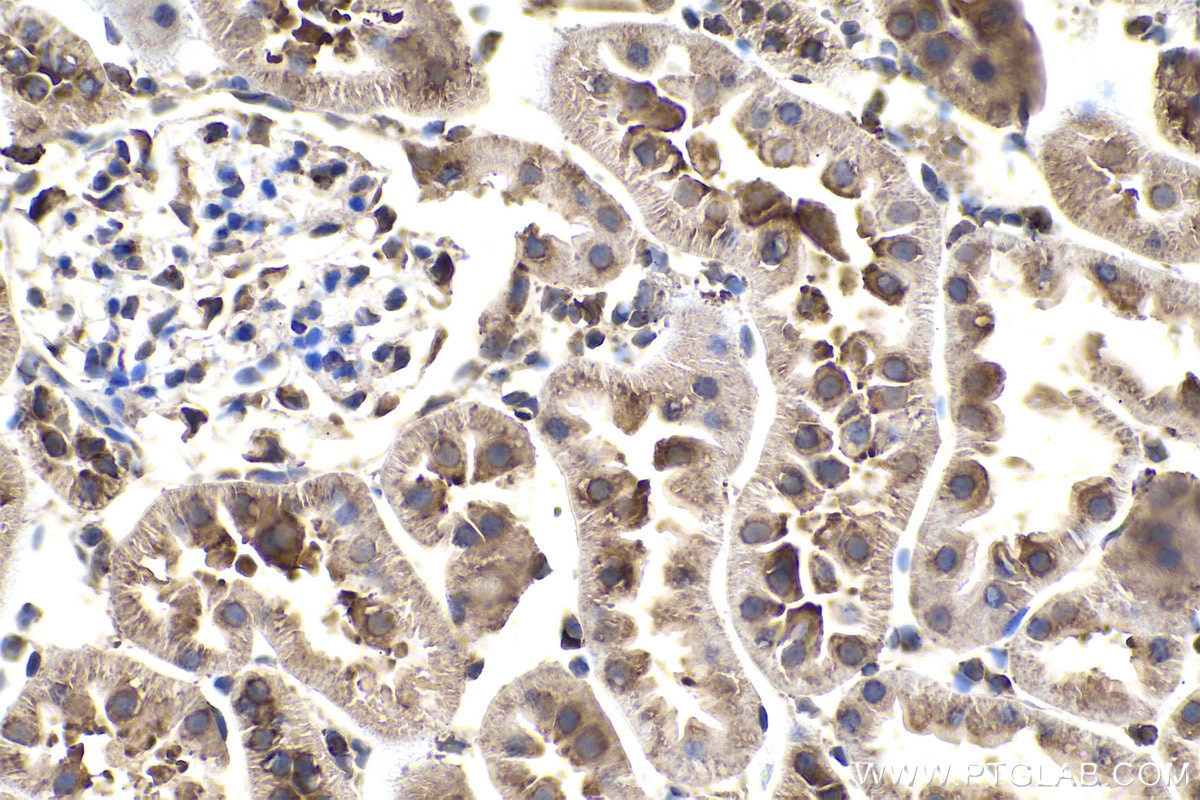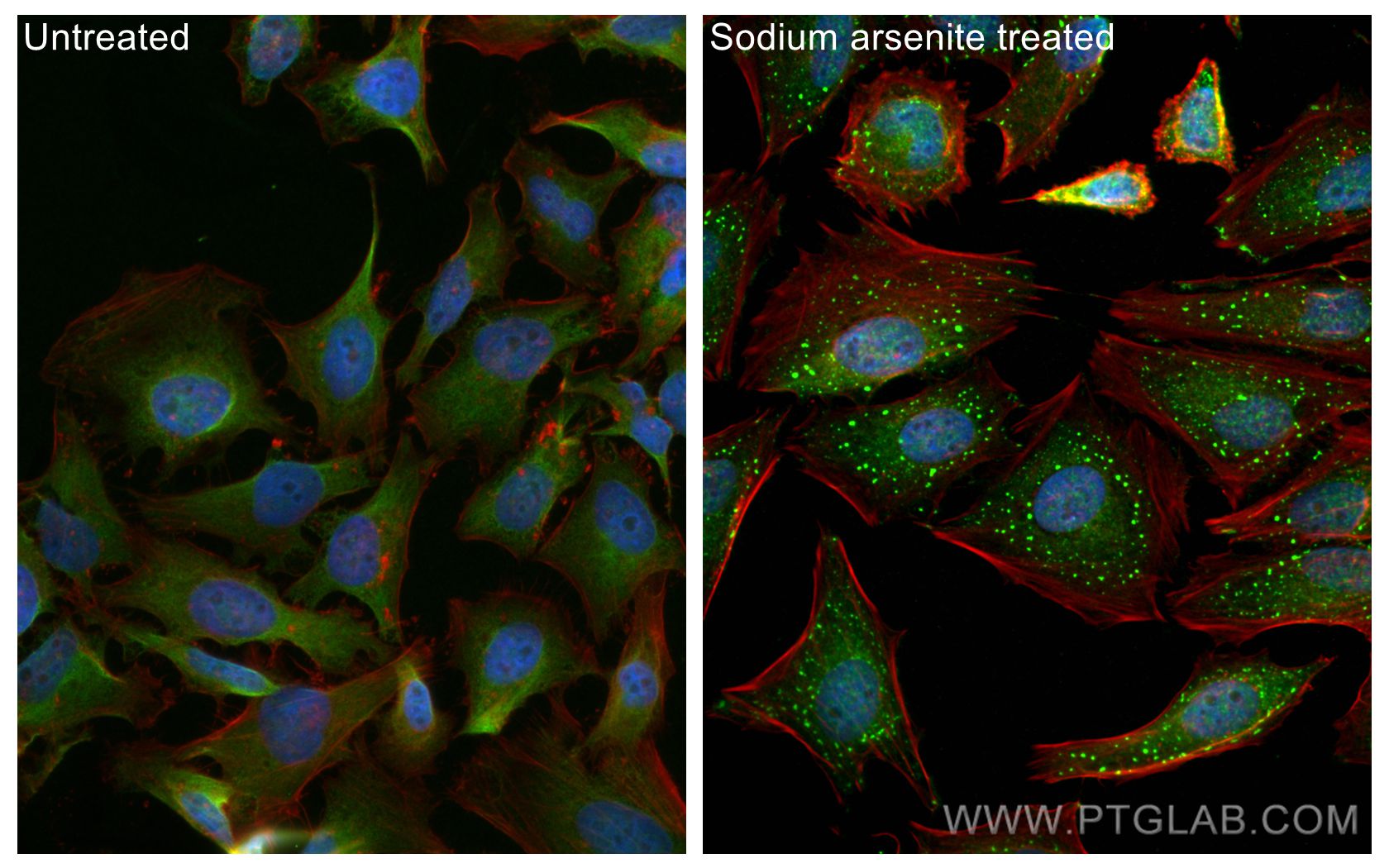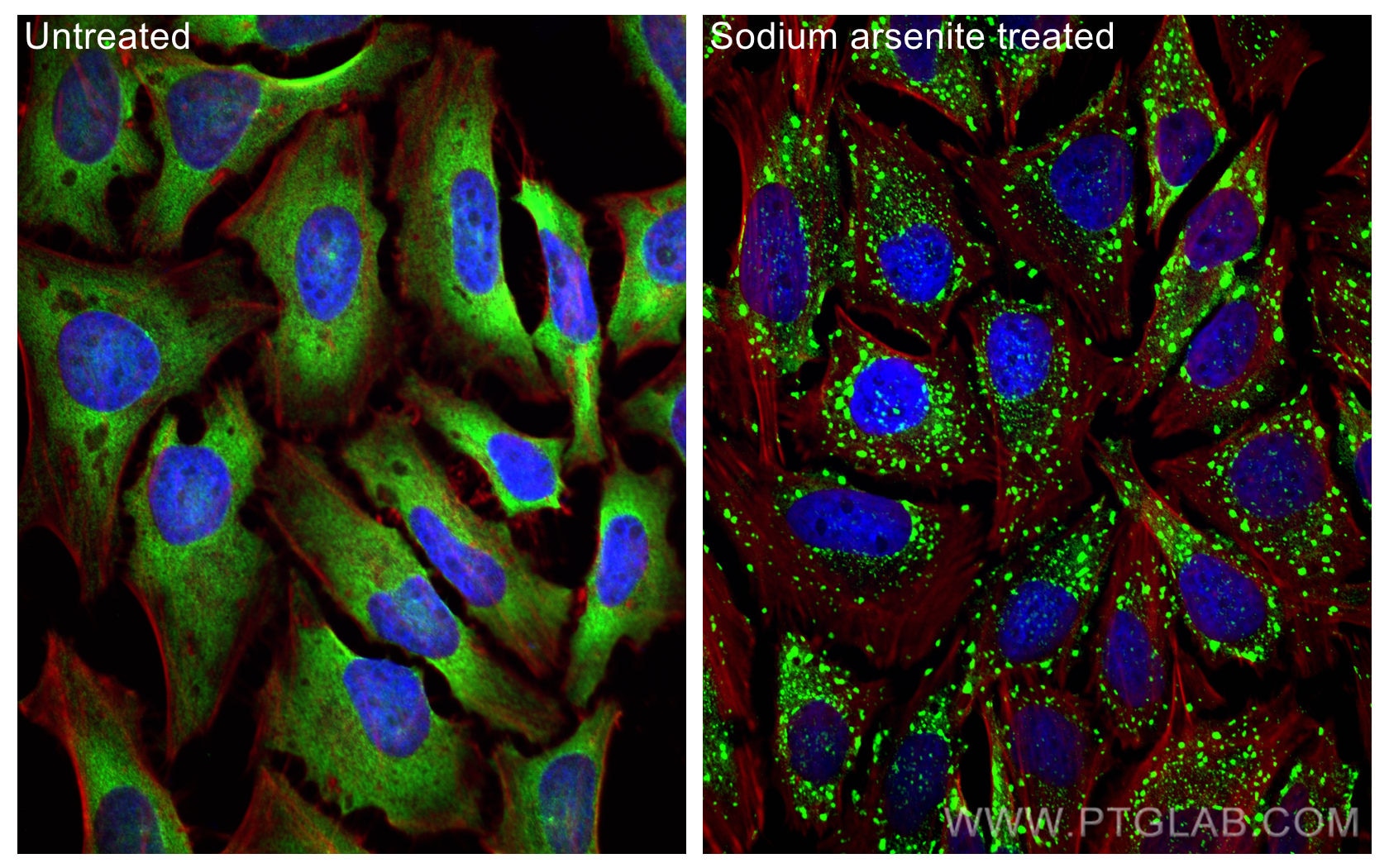Tested Applications
| Positive WB detected in | A549 cells, HEK-293 cells, HepG2 cells, MCF-7 cells, T47D cells, HeLa cells, Jurkat cells, Neuro-2a cells, C2C12 cells, C6 cells |
| Positive IP detected in | HeLa cells |
| Positive IHC detected in | human lung cancer tissue, mouse liver tissue, rat kidney tissue Note: suggested antigen retrieval with TE buffer pH 9.0; (*) Alternatively, antigen retrieval may be performed with citrate buffer pH 6.0 |
| Positive IF/ICC detected in | sodium arsenite treated HeLa cells |
Recommended dilution
| Application | Dilution |
|---|---|
| Western Blot (WB) | WB : 1:2000-1:16000 |
| Immunoprecipitation (IP) | IP : 0.5-4.0 ug for 1.0-3.0 mg of total protein lysate |
| Immunohistochemistry (IHC) | IHC : 1:250-1:1000 |
| Immunofluorescence (IF)/ICC | IF/ICC : 1:50-1:500 |
| It is recommended that this reagent should be titrated in each testing system to obtain optimal results. | |
| Sample-dependent, Check data in validation data gallery. | |
Published Applications
| KD/KO | See 6 publications below |
| WB | See 24 publications below |
| IHC | See 3 publications below |
| IF | See 14 publications below |
| IP | See 5 publications below |
| CoIP | See 2 publications below |
| RIP | See 1 publications below |
Product Information
16276-1-AP targets G3BP2 in WB, IHC, IF/ICC, IP, CoIP, RIP, ELISA applications and shows reactivity with human, mouse, rat samples.
| Tested Reactivity | human, mouse, rat |
| Cited Reactivity | human, mouse, monkey |
| Host / Isotype | Rabbit / IgG |
| Class | Polyclonal |
| Type | Antibody |
| Immunogen |
CatNo: Ag9355 Product name: Recombinant human G3BP2 protein Source: e coli.-derived, PGEX-4T Tag: GST Domain: 97-449 aa of BC011731 Sequence: LLSNSGQPERKFMQTFVLAPEGSVPNKFYVHNDMFRYEDEVFGDSEPELDEESEDEVEEEQEERQPSPEPVQENANSGYYEAHPVTNGIEEPLEESSHEPEPEPESETKTEELKPQVEEKNLEELEEKSTTPPPAEPVSLPQEPPKPRVEAKPEVQSQPPRVREQRPRERPGFPPRGPRPGRGDMEQNDSDNRRIIRYPDSHQLFVGNLPHDIDENELKEFFMSFGNVVELRINTKGVGGKLPNFGFVVFDDSEPVQRILIAKPIMFRGEVRLNVEEKKTRAARERETRGGGDDRRDIRRNDRGPGGPRGIVGGGMMRDRDGRGPPPRGGMAQKLGSGRGTGQMEGRFTGQRR Predict reactive species |
| Full Name | GTPase activating protein (SH3 domain) binding protein 2 |
| Calculated Molecular Weight | 482aa,54 kDa; 449aa,51 kDa |
| Observed Molecular Weight | 65-70 kDa |
| GenBank Accession Number | BC011731 |
| Gene Symbol | G3BP2 |
| Gene ID (NCBI) | 9908 |
| RRID | AB_2878237 |
| Conjugate | Unconjugated |
| Form | Liquid |
| Purification Method | Antigen affinity purification |
| UNIPROT ID | Q9UN86 |
| Storage Buffer | PBS with 0.02% sodium azide and 50% glycerol, pH 7.3. |
| Storage Conditions | Store at -20°C. Stable for one year after shipment. Aliquoting is unnecessary for -20oC storage. 20ul sizes contain 0.1% BSA. |
Background Information
Stress granules (SGs) are cytoplasmic mRNA-protein condensates formed in response to cellular stressors, such as oxidative stress, ultraviolet radiation, and viral infection (1). The Ras-GTPase-activating protein-binding proteins (G3BPs), consisting of G3BP1 and G3BP2, are key nucleating factors essential for SG formation. They function to protect RNAs from harmful conditions. G3BP2 is mainly distributed in the cytoplasm and participates in the formation of stress granules, cell differentiation, proliferation, and signal transduction. Accumulating evidence has demonstrated that aberrant expression of G3BP2 contributes to cancer initiation and progression, such as high expression of G3BP2 increasing cell stemness, metastasis and chemoresistance in breast cancer.
Protocols
| Product Specific Protocols | |
|---|---|
| IF protocol for G3BP2 antibody 16276-1-AP | Download protocol |
| IHC protocol for G3BP2 antibody 16276-1-AP | Download protocol |
| IP protocol for G3BP2 antibody 16276-1-AP | Download protocol |
| WB protocol for G3BP2 antibody 16276-1-AP | Download protocol |
| Standard Protocols | |
|---|---|
| Click here to view our Standard Protocols |
Publications
| Species | Application | Title |
|---|---|---|
Cell Diverse CMT2 neuropathies are linked to aberrant G3BP interactions in stress granules | ||
Cell G3BP1 Is a Tunable Switch that Triggers Phase Separation to Assemble Stress Granules. | ||
Cell Rep hnRNPA2B1 represses the disassembly of arsenite-induced stress granules and is essential for male fertility | ||
Oncogene HDAC6-G3BP2 promotes lysosomal-TSC2 and suppresses mTORC1 under ETV4 targeting-induced low-lactate stress in non-small cell lung cancer
| ||
Oncogene RIOK1 mediates p53 degradation and radioresistance in colorectal cancer through phosphorylation of G3BP2.
| ||
Mol Cancer Invasion-related circular RNA circFNDC3B inhibits bladder cancer progression through the miR-1178-3p/G3BP2/SRC/FAK axis.
|
Reviews
The reviews below have been submitted by verified Proteintech customers who received an incentive for providing their feedback.
FH Karine (Verified Customer) (09-22-2022) | Proteins were extracted from H69 cells using Laemmli lysis buffer (12.5mM Na2HPO4, 15% glycerol, 3% sodium dodecyl sulfate [SDS]). The protein concentration was measured with the DC Protein Assay (BIO-RAD) and 30μg of total proteins were loaded onto 12% SDS- polyacrylamide gels for electrophoresis and transferred onto polyvinylidene difluoride membranes (Millipore). After 1h of blocking with 5% bovine serum albumin prepared in Phosphate-Buffered Saline (PBS)-0.1% Tween-20 buffer, the blots were incubated overnight at 4°C with the indicated antibody (dilution 1/1000). After 1h of incubation with a horseradish peroxidase-conjugated secondary antibody (1:5,000, Promega), protein bands were visualized using an enhanced chemiluminescence detection kit (Millipore) and and the Syngene Pxi4 imaging system (Ozyme).
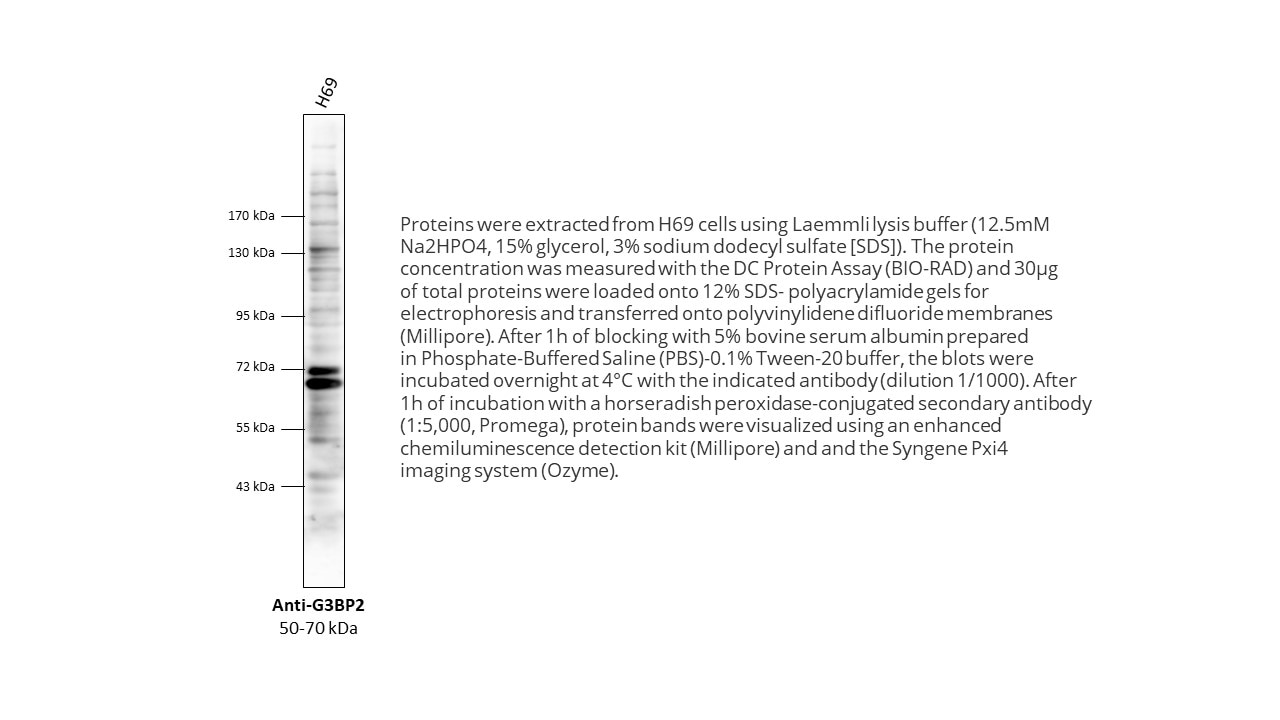 |

